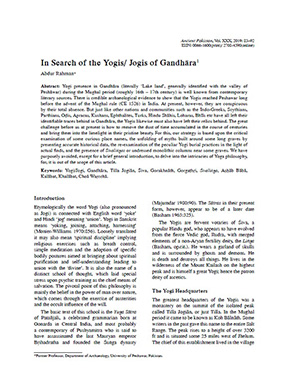In Search of the Yogis/ Jogis of Gandhāra
Keywords:
Gandhāra, Yogi, Jogi, Tilla Jogiān, Śiva, Gorakhnāth, Gorgaṭhṛi, Śivaliṅga, Aṣḥāb Bābā, Kalābat, Khalābat, Choā WaṛcchāAbstract
Yogi presence in Gandhāra (literally ‘Lake land’, generally identified with the valley of Peshāwar) during the Mughal period (roughly 16th – 17th century) is well known from contemporary literary sources. There is credible archaeological evidence to show that the Yogis reached Peshawar long before the advent of the Mughal rule (CE 1526) in India. At present, however, they are conspicuous by their total absence. But just like other nations and communities such as the Indo-Greeks, Scythians, Parthians, Oḍis, Apracas, Kushans, Ephthalites, Turks, Hindu Shāhis, Loharas, Bhīls etc have all left their identifiable traces behind in Gandhāra, the Yogis likewise must also have left their relics behind. The great challenge before us at present is how to remove the dust of time accumulated in the course of centuries and bring them into the limelight in their pristine beauty. For this, our strategy is based upon the critical examination of some curious place names, the unfolding of myths built around some long graves by presenting accurate historical data, the re-examination of the peculiar Yogi burial practices in the light of actual finds, and the presence of Śivaliṅgas or undressed monolithic columns near some graves. We have purposely avoided, except for a brief general introduction, to delve into the intricacies of Yoga philosophy, for, it is out of the scope of this article.

Downloads
Published
How to Cite
Issue
Section
License
Copyright (c) 2019 Ancient Pakistan

This work is licensed under a Creative Commons Attribution-NonCommercial 4.0 International License.
All Rights Reserved © Department of Archaeology, University of Peshawar




